#which allows for slightly more length variability
Explore tagged Tumblr posts
Text
More than friends
Sawyer did not expect what he found when he went to return a book he had borrowed from Nemo, it was a translated book of folktales from his home country, a lot of them were really interesting and the American was sure Nemo would want to know which ones he liked the best.
It would be fun talking it... what was that?
Voices
From the captain's room? That was strange to say the least.
Nemo was not in the habit of allowing people into his room, Sawyer had even waited outside the door when the captain went to fetch the book for him to borrow, the man liked his privacy, and it was pretty much the biggest unspoken rule, do.not.go.into.Nemo's.room unless you wanted an angry Indian on your ass.
Who would Nemo let in there? Ishmael had been the only one allowed from what he remembered who could enter without risk of Nemo's wrath.
Curiosity won out over self-preservation.
Leaning down, Sawyer looked through the crack in the door, careful to not lean too far forward for fear of bumping the door open and exposing himself.
Oh, it was just Jekyll, was Nemo not feeling well? Or did the doc have a problem? Both looked like they were doing alright...
0-0-0-0-0-0-0
"It will be fine, Henry" Nemo said, holding out a small dagger to the other man who looked hesitant "You can not always rely on Mr.Hyde, there are many variables in a fight, if you can't get to your elixir in time, or it is broken, or you just find yourself alone and in danger after the fact, you should know how to use weapons and martial arts properly,and after the incident with Mr. Quartermain, I think your lessons about firearms are on hold for the time being..."
Henry winced a bit at that
Sawyer did too
Oh, right, that day...
In all fairness, Allan did not tell him the safety was off before handing him the rifle...and yelling at him after it fired into the deck did not help the situation...nor had Skinner's attempt to add humor to the situation by taking the discharged rifle to sarcastically pose with the weapon, bad Scottish accent and all, which was odd because Tom heard him do one perfectly before, but he always seemed at the ready to piss Quartermain off, so there was that...
But, as usual, the captain had a point, couldn't always rely on your main weapon in a fight and needed to know other ways to win it, and Sawyer could teach the others how to use a gun just fine if Allan did not stop being prickly, could be fun even.
And Tom was not about to pass up his own lesson from Nemo, even if the captain did not know he was giving it...Tom could always ask properly later for a few pointers.
Henry took the dagger, it was nothing overly large or small, the blade being about the same length as the doctor's palm.
"Comfortable?"
"Not particularly, but I think that is more about me than the knife itself" Jekyll admitted, opening and closing his hand slightly on the handle, testing how it felt, he was used to Hyde grabbing blunt objects that he could use to turn his opponents into bloody paste, but nothing that required much skill to use, just grab and go for the head.
"Don't be afraid of it, Henry, I will not say it won't bite you a few times during your training as you learn, but if you are frightened of it, you are just assuring an accident, not preventing one" Nemo admitted.
That was really true, more than a few people got scared and then ended-wait...why was Nemo calling the doc by his name? He always called him 'doctor' or 'Jekyll' never by his first name.
But, the two were in private, maybe that had something to do with it? The two did seem like they were good friends ever since the incident in Mongolia, and both were what Sawyer would consider kinda prudish at times, so them having open moments of friendship like him and Huck had was not too surprising.
A hand going to the doctor's lower back broke Tom out of his thoughts.
Woah, physical contact? From Nemo? What was that about?
Another hand came up to cradle the taller man's wrist causing a blush to form.
"Steady grip Dilruba, straight back, show confidence, just that alone can help you in a fight, show your enemy no fear and allow doubt to root in their mind from it" Nemo instructed, a small quirk of his lip showing that he saw the blush.
"You make it sound so easy, not all of us are capable of such feats without any effort" Henry quipped back mildly offering a more visible smirk back at the captain though red still dusted his face.
"I do appreciate the compliment" Nemo returned "though it does not afford you getting out of this"
"Drat" was Henry's reply with a tone Sawyer could not place.
This was confusing, the two were acting almost like-
The two unknowing observee's suddenly locked lips in a kiss that was obviously not a friendship one, giving their literal peeping Tom more than he bargained for.
"Perhaps I can buy myself a small reprieve then?"
Sawyer did not even care if his footsteps were heard as he bolted away, red in the face and head swirling.
He shouldn't have seen that! He shouldn't have seen that!!!
----
Why do I love embarrassing Tom so much?
And this is just meant to be a silly little oneshot to try and unclog my writers block for my other fanfic, but if anyone has any ideas for a future NemoxJekyll fic, I would love to hear them.
#lxg#league of extraordinary gentlemen#the league of extraordinary gentlemen#dr henry jekyll#jekyll and hyde#edward hyde#jekyll#nemoxjekyll#nemo#captain nemo#tom sawyer#secret relationship#accidental voyeurism
12 notes
·
View notes
Text
Although land crabs regularly appear in the exotic pet trade, there is not much care information around for these species, excepting the most widely traded of the land hermit crabs, Coenobita clypeatus. For a while much confusion surrounded the rainbow crab of West Africa, Cardisoma armatum, and the moon crabs of the grnus Gecarcinus, which are imported from the opposite side of the Atlantic. I had myself thought the moon crabs, traded at a smaller size than the rainbow crabs, were a growth stage of that species. The similarities were not merely superficial, because both genera are members of Gecarcinidae, a major clade of land dwelling crabs. At least two species of Gecarcinus were turning up, these being G. lateralis and G. quadratus.
A well studied species, G. lateralis might be thought of as the ordinary moon crab, and most of my scientific information pertains from descriptions of this species, which is also called the Bermuda land crab and the black-back land crab, as well as some other names. Whatever it is being called, G. lateralis is present in coastal environments, where it lives above the tide mark, including where there is no standing water. Reportedly G. lateralis can grow to attain a carapace as long as 10 to even 12 centimeters, or 4 to almost 5 inches, and a legspan that is 15 centimeters or 6 inches. If such specimens exist then they are rare. A study of the burrowing behavior of this species in forest habitat, did not indicate any of such large crabs, their carapaces measuring closer to 5 centimeters or 2 inches when mature. However in a related species, G. ruricola, large males and slightly smaller females are demonstrated to possess carapaces about 9 centimeters wide, whilst 5 or 6 centimeters would be a more common carapace width.
The related species G. quadratus also has many names, but the Halloween (moon or land) crab is by far the most widely encountered, at least in the exotic pet trade. It may also be encountered with the labelling of harlequin land crab, among others. These two names do not seem to be in use when referring to any other Gecarcinus species, all of which may for example be referred to as red land crabs or moon crabs - labels shared with land crabs from other gecarcinid genera. G. quadratus is a native of the coastal rainforests of Mexico and the Panamanian land bridge, that attaches North to South America. This species has a carapace length of about 5 centimeters or 2 inches. I do not have a clue as to how variable in size this species of Gecarcinus is. Although it is clear that mature members of species in Gecarcinus, may show size variation.
Although Gecarcinus sp. larvae are dependent upon saltwater for their survival, the adult crabs have no such requirement. Although they might be found on beaches and in estuarine environments, adult G. lateralis died at salinities of 30 and 35 ppt, whereas they flourished in freshwater, and at lower salinities of 15 and 20 ppt. I do not have information about the salinity tolerance of G. quadratus, but adults belonging to both species do perfectly fine with access only to fresh water. These crabs are obligate air breathers and no not, in fact, require an aquaterrarium, provided their substrate is damp, or they have access to shallow water in a bowl or dish. This is because these crabs take up water using their abdomens. G. lateralis is also known to ingest damp sand for its moisture content.
Both G. lateralis and G. quadratus are present in environments where the substrate allows for burrowing behavior, and there is plenty leaf litter. Conspecific crabs are present in vast numbers, might share an environment, and this might be thought apt for these species the aquaterrarium, considering their herding habits in the wild. Nonetheless, each of these crabs will need space to avoid the behavioral incidents arising from overstocking. Cohabiting crabs would also need a complex environment, which they can use to avoid confrontations among their kind when necessary, not least if they are molting, because the presence of conspecifics reduces the survival of molting crabs. These crabs molt inside their own burrows for protection during this vulnerable, temporary time. Although this genus has strong herbivorous leanings, the older crabs are known to kill their juvenile conspecifics for food, especially when they are under nutrient stress
Gecarcinus are classed among the herbivorous crabs, and they do possess the abilities to digest cellulose, and consume fibrous plant materials. However their herbivory is not total, and foods of animal origins are accepted. Their diets are 80% vegetarian whereas it is only 10% of arthropod origins, and they can consume both green and brown (dead) plant matter. Although they prefer to eat fresh plant material, the wild crabs might consume more leaf litter. G. lateralis is a significant consumer of seeds, fruits, and propagules, avoiding vegetable foods with strong alkaloid defences. There is reason to believe genus Gecarcinus consume a broader spectrum of foods in the dry season, including fruits and carrion. Cannibalism in these crabs increases when access to nitrogen is decreased.
Gecarcinus sp. are burrowing crabs, and they use their burrows to shelter in less hospitable seasons, plugging their burrow and storing leaves as their food supply, when the temperature drops and the air humidity decreases. This behavior assists them avoiding water loss in the dry season. For this reason the air temperatures in the vivarium housing Gecarcinus sp. should not drop as low as 15-18 degrees centigrade, unless one wishes to stimulate such behaviors, by simulating a Caribbean dry season. The crabs seem to use decreasing air temperature as their cue for this behavior, but are triggered to resume behavioral normalcy by increased rains and the return of higher air humidity.
These crabs in the vivarium require a dump substrate and a high air humidity of over 80%, based on the humidity inside crab burrows. The diurnal air temperature range, on a similar basis, should be closer to 28 degrees than to 20 degrees centigrade. People report success when keeping this species at 26 or 27 degrees by day. I have read that this temperature must not be allowed to fluctuate, but in the wild the air temperature in their habitats does drop a little by night, and Gecarcinus are night as well as day active foragers. If the environment makes them unhappy they will retreat into the microhabitats of their burrows. Although not necessary, these air breathing land crabs are easily accommodated in a paludarium, with a large land portion simulating a tropical forest floor.
The water portion of an aquaterrarium assists in maintaining a high air humidity, but these crabs do need to safely leave the water should they walk or fall in. For this reason any water area should be of a shallow depth, and the substrate ought to slope out of the water. As with all humid vivaria, it is also important that there is sufficient ventilation. Although the air should have a high moisture content, it does not follow that it be stagnant. I have not heard reports of Gecarcinus sp. being mixed with other species of land or water animals. However, gecarcinid crabs are strongly inclined to eat live plants, and destroy planted landscapes.
Gecarcinus are primarily feeders on edible fruits and vegetables, that will also accept proprietary defrosted and dry foods intended for aquarium fishes. Although they are predominantly vegetarians, Gecarcinus diets in the aquaterrarium should also include some animal proteins, to reflect their natural consumption of arthropod material, but they will also consume soybean based foods that offer a similar boost of nutrients. The opportunistic consumption of animal matter is a well known phenomenon in terrestrial crabs with herbivorous specializations.
#moon crabs#aquaterrarium pets#amphibious crabs#land crabs#genus gecarcinus#Gecarcinus lateralis#Gecarcinus quadratus#Bermuda land crab#red land crab#black-back land crab#halloween land crab#harlequin land crab#herbivorous crabs
3 notes
·
View notes
Text
/Video input received/
/Source: HS: IR-15/
/Starting transcript/
…
[The camera is looking at the Mall’s medical wing, it’s a bit busier than average, lots of people standing around and waiting, but the camera doesn’t focus on any specific person as Iris approaches the area]
Iris: [Loudly] Ahem, hellooo, I’m looking for the doctor who has the balls to just call themselves “Doctor”, has plain brown hair that’s about shoulder length at least as of her last employee photo picture?
???: [Nurse?] They're all named Doctor, and there’s multiple with the same hair color. Do you... need assistance? Are you looking for a mechanic?
[The camera turns to look at the nurse who started speaking, and Iris just lets out a long slow sigh]
Iris: That’s fucking stupid, you don’t even use like, employee numbers to tell the doctors apart? Ugh, whatever.
Nurse: Do you know her number, so we can better assist and get you a time to see her?
[The world blurs for a second as Iris rolls her eye before focusing back on the nurse]
Iris: Fucking like, 143 or something? And I’m sure if you mention to her it’s Iris, she’ll drop whatever it is she’s busy with.
[The nurse studies her, and the look past the stage theater half mask implies he agrees with her, as he nods and heads further into the commotion to retrieve the Doctor.]
[As the camera follows the retreating nurse, Iris’ hand comes into frame as she studies her nails. Which are currently bright red and clearly sharped to a point, before it moves away as Iris shifts in place]
Doctor: You must be Iris! Hello, I heard you wanted to see me, I had hoped you’d visit, or I would get a chance to see you in person at some point!
[The woman matches the description Iris had given, though the white theater eye mask and purple eyes were more noticeable then her hair when she was seen walking towards the camera through the crowd of waiting people and department workers.]
Iris: Yeahhh, that’s definitely why I'm here, anyways, let’s head somewhere a bit less crowded, hm?
Doctor: I feel I might have been a bit overzealous in getting everyone to come for a checkup, so there isn’t really anywhere that is fully private currently. Would the break room be alright? There might be some nurses, but it’s the only place without patients waiting for a look from one of us.
[The camera lowers as Iris makes a sweeping motion with her arm, indicating for the Doctor to lead the way]
[ The Doctor smiles and turns, waving her forward as she leads to a corner room off to the side of the crowd. She goes through the door, to a mini kitchen area with a small seating area, and two nurses standing stationary near one of the walls with coffee untouched on the counter beside them. Doctor takes one of the empty seats at the table, looking to Iris. ]
[Iris takes a seat across from Doctor, and the camera’s view slightly tilts as Iris starts tapping her nails on the table]
Iris: So I’ll just get this first question out of the way, why are you such a coward?
Doctor: I don’t understand what you mean by that. I’ve only just met you. I am more interested in you though, how much of you is still organic?
Iris: Yeahhh, ‘fraid I don’t really care about answering anything you want to know. And what I mean is why are you still completely organic, and completely human?
Doctor: Oh, you’ve seen my department's research! Unfortunately, it seems all of it concludes it won’t work on people who are already adults. Hybridization is quite delicate, when it’s organic and not mechanical. As much as I had attempted to make a horse into a mule a few times given the chance. Maybe if the department had been allowed more time, we could have gotten things to work.
Iris: [undertone of static] Doesn’t change the fact that you’re a coward. What kind of doctor subjects people to something without having any idea personally what it might be like?
Doctor: Most doctors! Research is done on test subjects to allow the doctors to observe and learn, get the variables and formulas and papers properly written. It’d be bad for a doctor to test on themselves, as things could go wrong and then their research would be wasted as there would be no one to monitor everything that’s needed at the same time as everything else! It’s what an R&D department is all about, after all.
[Iris leans back in her chair, humming tunelessly]
Iris: No no, I’m not saying every doctor at once should test things themselves first, but you were the project lead, no? Shouldn’t you have wanted even half of an idea about what you were subjecting your subjects to?
Doctor: I don’t think you understand how research experiments are conducted, and I was of course given the head overseer title of the project at the beginning, which gave me the wonderful position of seeing how all my darlings were progressing. I read all of the notes, and it gave me a good idea of what was going on, in terms of successful tests and which ones needed tweaking.
[There’s a loud slam as Iris bangs her hand on the table, making direct eye contact with Doctor, and leaning forward]
Iris: You think I don’t know how research experiments are conducted? Tell me, and surely because you’re so interested in me you’ll know the answer, what exact position do I hold at Showfall?
Doctor: You're a Security, a remarkably aware one as well, it’s quite fascinating! I assume it was a lucky accident, but I haven’t gotten a chance to ask to see if you have a file I could look through yet.
[Iris bangs her fists repeatedly on the table as loud static bursts from Iris, before it slowly quiets into normal laughing as the camera tilts]
Iris: My fellow doctor, I am Head Security I’ll have you know, and before that, I was Lead Security Engineer, and before that? Well, most people just called me Doctor Ash. You think this was an accident? You think something like this, happens unintentionally? Well, then maybe you’re not as fit for this job as it originally seemed.
Doctor: My field of research isn’t engineering, but the more biological aspect of things. I have no insight into the way security is made, much less what Head Securities do as their jobs. I was hired for the job relating to medical sciences and studies, and have always done the absolute best I could, and it was through no fault of me or my teams own that the company decided to end one of our research projects before it had barely started! I suspect HR might have made it up, at this point, the way they seem to prevent me from seeing any of my darlings.
Iris: You know what, this might be only the second time I’ve ever fully agreed with any member of HR! You should not be allowed in the same building as them after what you did.
Doctor: The research project had been accepted, I did not do anything that Showfall hadn’t deemed allowed in the parameters.
Iris: That is because they put too much faith in you to pace yourself apparently! Seriously, jumping head first into a project like that? I don’t care how much more adaptable children are, You should have slowly worked down to experimenting on literal children! Not start with 5 adults and 15 kids!
Doctor: If Showfall had an issue, they would have told me to revise. Which they had done a few times, and why we began with as young as we could at shots before doing the rest when they were older, for the children. The adults were more... a control group, you could say. The potential was there for them to survive, same as the kids, but the rejection was clearly higher. Hypotheses never come out exactly as you’ll expect them, but with more chances to test the subjects, the higher the potential for success eventually becomes given time and resources. Besides, I had mentioned my attempts to change a horse into a mule hadn’t I? I tried animal tests first, before petitioning and asking for some human volunteers and getting the green light for it.
[The camera flicks around Doctor’s face, before lurching up as Iris stands]
Iris: Well then, it seems like I have complaints to file. Something like that should have never been approved, especially to be led by a doctor as stupid as you. Oh and another thing?
[Iris slams her hand onto the table once more, this time a small crack can be heard]
Iris: Leave Jasprix alone, you’ve done enough to him. You’ve gotten the research you need, from him. He quite clearly does not need any checkups, what with the regeneration you are quite aware he has now.
Doctor: Axolotls can still get ill, I worry for him, as I do the others that I haven’t been able to see. He’s not the only one that I’ve been trying to check on. I assume he’s your friend as well?
Iris: I think I’m going to include “Needs to be rewired to learn how to ‘take a hint’.” in my complaints, if you haven’t been able to see them, that’s damn well on purpose. So stop trying to focus on a past project that was discontinued for a fucking reason, and just focus on doing your damn job. If they need care, they’ll see whichever doctor they need to.
Doctor: None of the other doctors have seen them in years, so I doubt any of them are getting properly checked over. It’s part of my job to worry about their well beings, as my patients, to prevent illnesses and injuries. They could have been injured or ill over these past years, and not gotten any care. Regardless of if one of them heals from injuries or not, illness is still a danger.
[Doctor sighs, leaning back with her arms crossed.]
Doctor: You’ll be making a complaint against Showfall itself, since it was its experiment, regardless of if I conducted it or not.
Iris: Nothing I haven’t done before. I’ll be taking my leave now, as it seems that official paperwork is the only way I’ll have a chance to get through that thick skull of yours.
Doctor: It was a pleasure to see you, despite this talk. Tell Jasper I said hello, would you?
Iris: I’m afraid I don’t know anyone named “Jasper”, and before you say anything, I’ll think you’ll find that certain paperwork has in fact recently been filed.
[Iris quickly turns and leaves before Doctor has a chance to respond]
…
/Video input ended/
/Uploading transcript.../
/Upload successful!/
5 notes
·
View notes
Text
Choosing the right prime where to buy lenses for low-light photography
Choosing the right prime where to buy lenses for low-light photography involves considering several key factors, such as the maximum aperture, where to buy lenses build quality, and your specific shooting needs. Here are some tips and recommendations based on the latest reviews and expert opinions:
Key Factors to Consider
Maximum Aperture:
Look for prime where to buy lenses with wide apertures like f/1.4, f/1.8, or f/2.0. These apertures allow more light to enter the camera, which is crucial for low-light photography。
For example, an f/1.4 where to buy lenses allows significantly more light compared to an f/2.8 where to buy lenses, enabling you to use faster shutter speeds and lower ISO settings。
where to buy lenses Build and Quality:
Durability: A robust build quality ensures the where to buy lenses can withstand different shooting conditions。
Weather Sealing: If you plan to shoot in variable weather conditions, consider a where to buy lenses with weather sealing。
Autofocus Speed: Fast autofocus helps in capturing sharp images quickly, especially in low light。
Versatility and Focal Length:
50mm where to buy lenses: A 50mm prime where to buy lenses is versatile and works well for portraits and general photography. The Canon EF 50mm f/1.8 STM is a budget-friendly option that performs well in low light。
35mm where to buy lenses: A 35mm prime where to buy lenses is great for street photography and low-light indoor shots. The Nikon AF-S DX 35mm f/1.8 G is a good choice for APS-C cameras。
85mm where to buy lenses: For portraits in low light, an 85mm where to buy lenses like the Canon EF 85mm f/1.4L IS USM offers excellent sharpness and background blur。 Top Recommendations
Sigma 50mm f/1.4 Art where to buy lenses:
Pros: Exceptional sharpness, beautiful bokeh, fast f/1.4 aperture, robust build quality.
Cons: Heavier and more expensive compared to some other options.
Ideal For: Portrait photographers, wedding photographers, and those seeking high image quality.
Canon EF 50mm f/1.4 USM:
Pros: Affordable, versatile, fast autofocus, and good low-light performance.
Cons: Autofocus can be noisy, and build quality is less robust than premium where to buy lenses.
Ideal For: Portrait and wedding photographers, street photographers, and amateurs looking for an upgrade.
Viltrox 56mm f/1.7:
Pros: Excellent optical quality, smooth bokeh, and affordable。
Cons: Limited focal length versatility, autofocus may not be as fast as more expensive options.
Ideal For: Portrait enthusiasts and video creators.
Viltrox 20mm f/2.8:
Pros: Wide-angle where to buy lenses with good low-light performance, compact and lightweight.
Cons: f/2.8 aperture may not be as fast as f/1.4 or f/1.8 where to buy lenses.
Ideal For: Landscape and architectural photographers, travelers. Budget Considerations
If you are on a budget, the Canon EF 50mm f/1.8 STM is an excellent entry-level option that performs well in low light and is very affordable.
For a slightly higher budget, the Sigma 50mm f/1.4 Art where to buy lenses offers superior image quality and build quality. Conclusion When choosing a prime where to buy lenses for low-light photography, prioritize where to buy lenses with wide apertures (f/1.4 or f/1.8) and consider your specific needs, whether it’s portraiture, street photography, or landscapes. The Sigma 50mm f/1.4 Art where to buy lenses is a top choice for its performance and build quality, while the Canon EF 50mm f/1.4 USM offers a more affordable alternative without compromising too much on quality.
0 notes
Link
0 notes
Link
0 notes
Text
The Engineering Behind Parabolic Leaf Springs: How They Work

Parabolic leaf springs are a sophisticated advancement in vehicle suspension technology, offering enhanced performance and comfort compared to traditional leaf springs. Their unique design and engineering principles are pivotal in achieving superior ride quality, load distribution, and durability. This article explores the engineering fundamentals behind parabolic leaf springs, how they function, and the benefits they offer.
Understanding Leaf Springs
To appreciate the engineering of parabolic leaf springs, it's essential first to understand the basic function and design of traditional leaf springs. Conventional leaf springs consist of multiple layers of steel, known as leaves, stacked together in a linear fashion. These leaves are clamped together and mounted to the vehicle's axle, where they act as a spring by flexing under load.
The primary roles of traditional leaf springs include:
1. Load Bearing: They support the vehicle's weight and any additional cargo.
2. Shock Absorption: They absorb road shocks and distribute forces to prevent excessive bouncing.
3. Stability and Control: They help maintain axle alignment and vehicle stability.
Despite their effectiveness, traditional leaf springs have limitations, such as limited ride comfort and reduced flexibility under varying loads.
The Evolution to Parabolic Leaf Springs
Parabolic leaf springs address many of the shortcomings of traditional leaf springs through their innovative design. Unlike linear leaf springs, parabolic leaf springs have a curved shape that resembles a parabola, which introduces significant changes in how they perform.
Design Characteristics of Parabolic Leaf Springs:
1. Parabolic Curve: The key feature of parabolic leaf springs is their curved, parabolic shape. This design contrasts with the straight or slightly curved shape of traditional leaf springs. The curve allows for a more gradual transition of forces along the length of the spring.
2. Variable Thickness: Parabolic leaf springs typically have varying thickness along their length, being thicker at the center and tapering off towards the ends. This design enables the spring to offer a progressive response to loading, improving both load support and ride comfort.
3. Reduced Leaf Count: Parabolic leaf springs usually consist of fewer leaves than traditional leaf springs. The reduced number of leaves contributes to a lower overall weight and less friction between the leaves, enhancing performance.
Engineering Principles Behind Parabolic Leaf Springs
The engineering behind parabolic leaf springs revolves around several key principles:
1. Load Distribution
- Parabolic Shape: The parabolic curve allows for a more uniform distribution of stresses and forces. Unlike traditional leaf springs, where stress is concentrated at specific points, the parabolic shape spreads the load more evenly along the length of the spring. This reduces localized stress and minimizes the risk of fatigue or failure.
- Variable Stiffness: The varying thickness of the leaf spring contributes to its progressive stiffness. When a load is applied, the spring’s central section, which is thicker, absorbs the majority of the load. As the load increases, the tapering ends engage, providing additional support and flexibility.
2. Flexibility and Ride Quality
- Progressive Spring Action: Parabolic leaf springs exhibit a progressive spring action, meaning that their stiffness increases with the amount of load. At lower loads, the spring is more flexible, providing a smoother ride. As the load increases, the spring becomes stiffer, improving load-bearing capacity and stability.
- Reduced Friction: With fewer leaves and a more advanced design, parabolic leaf springs experience less internal friction compared to traditional leaf springs. This reduction in friction leads to less energy loss and smoother movement, contributing to improved ride comfort and handling.
3. Durability and Strength
- Stress Reduction: The parabolic design helps to reduce the stress concentration points found in traditional leaf springs. By distributing stresses more evenly, parabolic leaf springs are less prone to cracks or failures, resulting in greater durability and longevity.
- Material Efficiency: The advanced design allows for the use of higher-strength materials without increasing the overall weight of the spring. This efficiency enhances both the performance and lifespan of the suspension system.
The Manufacturing Process
The manufacturing of parabolic leaf springs involves several precise steps to ensure optimal performance and quality:
1. Material Selection: High-strength steel or composite materials are selected for their durability and flexibility. The choice of material is crucial for achieving the desired balance of strength and ride quality.
2. Shaping and Forming: The steel is heated and shaped into the parabolic curve using specialized equipment. The forming process requires careful control to achieve the correct curvature and thickness variations.
3. Heat Treatment: After shaping, the leaf springs undergo heat treatment to enhance their mechanical properties. This process involves heating the springs to a specific temperature and then cooling them rapidly to increase their strength and elasticity.
4. Surface Treatment: To protect against corrosion and improve longevity, the leaf springs are coated with protective layers, such as powder coating or galvanizing.
5. Assembly and Testing: The finished leaf springs are assembled with any necessary components and subjected to rigorous testing to ensure they meet performance and safety standards.
Performance Benefits of Parabolic Leaf Springs
The unique engineering of parabolic leaf springs results in several key performance benefits:
1. Enhanced Ride Comfort: The progressive action and reduced friction of parabolic leaf springs contribute to a smoother ride. The springs effectively absorb road irregularities and provide better cushioning, improving overall driving comfort.
2. Improved Load Handling: Parabolic leaf springs offer better load support and stability compared to traditional leaf springs. Their ability to handle varying loads without compromising ride quality makes them suitable for a range of applications, from heavy-duty trucks to off-road vehicles.
3. Increased Durability: The even stress distribution and reduced friction of parabolic leaf springs result in increased durability. These springs are less likely to suffer from fatigue or wear, leading to longer service life and reduced maintenance needs.
4. Better Handling and Stability: The progressive stiffness of parabolic leaf springs enhances vehicle handling and stability. The springs provide consistent performance under different loading conditions, contributing to improved control and safety.
Applications and Real-World Examples
Parabolic leaf springs are used in various applications where enhanced performance and comfort are critical. Some notable examples include:
1. Off-Road Vehicles: Parabolic leaf springs are commonly used in off-road vehicles, where their ability to handle rough terrain and varying loads provides significant advantages in terms of ride comfort and durability.
2. Heavy-Duty Trucks: In heavy-duty trucks, parabolic leaf springs offer improved load-carrying capacity and stability, making them suitable for transporting heavy loads over long distances.
3. Luxury Vehicles: Some luxury vehicles utilize parabolic leaf springs to provide a smoother and more comfortable ride, enhancing the overall driving experience.
4. Commercial Fleet Vehicles: Fleet operators benefit from the durability and reduced maintenance requirements of parabolic leaf springs, leading to lower total cost of ownership and improved vehicle uptime.
The engineering behind parabolic leaf spring represents a significant advancement in suspension technology. By leveraging the principles of load distribution, progressive stiffness, and reduced friction, parabolic leaf springs offer enhanced ride comfort, improved load handling, and increased durability. Their unique design and manufacturing process result in a suspension system that is well-suited for a variety of applications, from off-road adventures to heavy-duty trucking. Understanding the physics and engineering behind parabolic leaf springs helps to appreciate their benefits and the role they play in modern vehicle suspension systems.
0 notes
Text
Choosing the Right Ski Gear: Tips for Selecting Skis, Boots, and Accessories
Skiing is a thrilling winter sport that combines the beauty of snow-covered landscapes with the excitement of racing down slopes. However, to fully enjoy the experience, having the right ski gear is essential. The proper equipment enhances performance and ensures safety on the slopes. In this guide, we'll explore how to choose the right skis, boots, and accessories, providing you with the knowledge to make informed decisions for your next ski adventure.
Understanding Your Skill Level and Ski Type
Before diving into the specifics of gear, it is important to assess your skill level and the type of skiing you plan to do. Ski gear is tailored to different levels, from beginners to advanced skiers, and for various kinds of skiing, such as alpine, cross-country, or freestyle. Understanding your needs will help you choose equipment that complements your abilities and skiing style.
For beginners, shorter and more flexible skis are ideal, as they are easier to control. Intermediate skiers might opt for skis with a bit more stiffness for better stability at higher speeds. Advanced skiers, on the other hand, often prefer longer, stiffer skis that can handle aggressive turns and varying snow conditions. Additionally, the type of skiing you'll be doing—cruising down groomed trails or tackling backcountry slopes—will influence your choice of skis.
Selecting the Right Skis
When selecting skis, several factors come into play: length, width, shape, and flex. Each of these characteristics affects how the skis perform in different conditions.
Ski Length: The length of your skis should correspond to your height and skiing ability. Shorter skis are easier to maneuver and are ideal for beginners or those who enjoy making quick, tight turns. Longer skis offer more stability at high speeds and are better suited for advanced skiers who prefer more aggressive skiing.
Ski Width: The width of your skis, particularly at the waist, determines how well they float in powder or handle hard-packed snow. Wider skis provide better flotation in deep snow, making them a good choice for off-piste and backcountry skiing. Narrower skis, on the other hand, are more responsive on groomed runs and are easier to edge.
Ski Shape: The shape of the ski, including the sidecut radius, influences how the ski turns. A deeper sidecut (a more pronounced hourglass shape) makes initiating and holding turns easier, which is beneficial for beginners and those who enjoy carving. A straighter ski is better for stability at high speeds and in variable snow conditions.
Ski Flex: The flex of the ski determines how much it bends under pressure. Softer skis are more forgiving and easier to turn, making them suitable for beginners. Stiffer skis provide more power and control, ideal for experienced skiers.
Choosing the Right Ski Boots
Ski boots are arguably the most important part of your ski gear. They are the interface between your body and the skis, and a good fit is crucial for comfort and performance.
Boot Fit: The fit of your ski boots is paramount. Boots should be snug but not painfully tight. When you're standing upright, your toes should touch the end of the boot, but when you bend your knees, your toes should pull slightly away from the front, allowing room for circulation. A common mistake is choosing too large boots, leading to poor control and discomfort.
Flex Index: Ski boots have a flex rating, which indicates how stiff they are. Beginners should opt for a lower flex index (around 60-80), which offers more comfort and easier flexion. Intermediate to advanced skiers might choose a stiffer boot (100 or higher), which provides more support and control at higher speeds.
Boot Sole: The sole of the ski boot is designed to work with specific bindings. Alpine boots typically have a flat sole, while touring or backcountry boots have a rockered sole to facilitate walking. Ensure your shoes are compatible with your bindings to avoid any safety issues.
Essential Ski Accessories
Beyond skis and boots, several accessories are essential for a comfortable and safe skiing experience.
Ski Poles: Ski poles assist with balance and rhythm while skiing. The correct length of the ski pole is important—when holding the pole upside down by the basket, your elbow should form a 90-degree angle. Poles also come in different materials, with aluminum being durable and affordable, while carbon fiber is lighter but more expensive.
Helmets: Helmets are a must for all skiers, regardless of skill level. Look for a snug helmet with adjustable vents to regulate temperature. Helmets with MIPS (Multi-directional Impact Protection System) technology offer additional protection against rotational forces in a fall.
Goggles: Ski goggles protect your eyes from the sun, wind, and snow. Choose goggles with lenses suited to the light conditions—yellow or gold lenses for low light and darker lenses for bright, sunny days. Anti-fogging technology and good ventilation are also important features to look for.
Gloves: Keeping your hands warm and dry is essential. Choose gloves that are waterproof, insulated, and offer good dexterity. Some gloves include touch-screen compatibility or built-in liners for added warmth.
Layers and Clothing: Dressing in layers is key to staying warm and comfortable on the slopes. Start with a moisture-wicking base layer, add an insulating mid-layer, and finish with a waterproof and breathable outer layer. Remember a neck gaiter or balaclava for extra protection against the cold.
Choosing the right ski gear involves understanding your skill level, skiing style, and the conditions you'll be facing. By selecting skis, boots, and accessories that suit your needs, you'll enhance your performance, stay comfortable, and, most importantly, stay safe on the slopes. Whether you're a beginner just starting or an advanced skier looking to upgrade your gear, investing time in selecting the right equipment will pay off in a more enjoyable and successful skiing experience.
0 notes
Text
Understanding Your Body: How Ovulation Calculators Work
Ovulation is a critical component of the menstrual cycle, and it plays a pivotal role in a woman's reproductive health. Knowing when you ovulate is not only essential for those trying to conceive but also for those who want to understand their bodies better and track their menstrual cycles. Ovulation calculators, often referred to as ovulation predictor kits (OPKs) or fertility apps, have become valuable tools in helping women pinpoint their fertile days. In this article, we'll delve into the intricacies of how ovulation calculators work, their accuracy, and the factors that can influence their results.
The Menstrual Cycle: Before we explore ovulation calculators, it's crucial to understand the basics of the menstrual cycle. The menstrual cycle is typically divided into two main phases: the follicular phase and the luteal phase.
Follicular Phase: This phase begins on the first day of your period and can vary in length from person to person. During this time, the follicle-stimulating hormone (FSH) is released, stimulating the ovaries to develop multiple follicles, each containing an immature egg.
Ovulation: Ovulation is the release of a mature egg from one of the follicles. It usually occurs around the middle of the menstrual cycle.
Luteal Phase: After ovulation, the luteal phase begins. This phase is characterized by the corpus luteum, a temporary endocrine structure that secretes progesterone. Progesterone prepares the uterine lining for potential implantation.
Understanding the menstrual cycle is crucial because it provides the foundation for how ovulation calculators work.
How Ovulation Calculators Work Ovulation calculators employ various methods to predict when a woman is likely to ovulate. Here are some common techniques:
Calendar Method: This method is based on the assumption that a woman's cycle is regular. It predicts ovulation by counting backward 14 days from the expected start date of the next period. For instance, if your cycle is consistently 28 days, ovulation is estimated to occur on day 14.
Basal Body Temperature (BBT) Tracking: BBT tracking involves taking your body temperature every morning before getting out of bed. Your temperature slightly increases after ovulation due to the rise in progesterone. A sustained elevated BBT can indicate that ovulation has occurred.
Cervical Mucus Analysis: Changes in cervical mucus consistency can also provide clues about ovulation. As you approach ovulation, your cervical mucus becomes clear, slippery, and stretchy, resembling egg whites.
LH Surge Detection: Ovulation predictor kits (OPKs) detect a surge in luteinizing hormone (LH) in your urine, which usually occurs 24-48 hours before ovulation. When the test line is as dark or darker than the control line, it suggests that ovulation is imminent.
Fertility Apps and Calculators: Numerous smartphone apps and online tools are available that use a combination of cycle length, previous menstrual data, and symptoms like cervical mucus changes to predict ovulation. Some apps also allow users to input BBT data for more accuracy.
Factors Affecting Accuracy While ovulation calculators can be very useful, it's important to remember that they are not foolproof. Several factors can influence their accuracy:
Cycle Irregularity: Ovulation calculators work best for women with regular menstrual cycles. If your cycle is irregular, the predicted ovulation date may not be accurate.
Stress and Illness: Stress, illness, or major lifestyle changes can affect the timing of ovulation. These calculators may not account for these variables.
Medications: Certain medications, such as fertility drugs or hormonal contraceptives, can impact the results of ovulation predictors.
Age: As women age, the predictability of their menstrual cycle can change. Ovulation calculators may not be as reliable for older women.
Underlying Health Conditions: Conditions like polycystic ovary syndrome (PCOS) can lead to irregular cycles, making ovulation prediction more challenging.
User Error: Inaccuracies can also result from improper use of BBT tracking or LH surge tests.
Ovulation calculators are valuable tools for women looking to understand their menstrual cycles, track fertility, or conceive. They use various methods to predict when ovulation is likely to occur, but their accuracy can be influenced by factors such as cycle irregularity, stress, medications, age, health conditions, and user error. It's essential to use these tools as a general guideline and consult a healthcare provider if you have concerns about your fertility or reproductive health.
0 notes
Text
Monopoly vs. Opoloy: A Comparative Guide to Board Games
Exploring the World of Classic Board Games
In an era of digital entertainment and screens galore, there's something undeniably charming about classic board games. They have a timeless appeal, drawing people of all ages together for hours of fun and friendly competition. Two such classics that have stood the test of time are Monopoly and Opoloy. In this comparative guide, we'll take a deep dive into these iconic board games, exploring their rules, gameplay, and the unique features that set them apart.
Understanding the Basics of Monopoly and Opoloy
Before we delve into the comparisons, let's start with a basic understanding of both games.
Monopoly Game: Monopoly is a classic board game known for its real estate-themed gameplay. Players buy, sell, and trade properties with the aim of bankrupting their opponents. The game involves strategic decision-making, negotiation, and a dash of luck.
Opoloy Game: Opoloy, on the other hand, is a lesser-known but equally engaging board game inspired by Monopoly. Like its predecessor, Opoloy revolves around property acquisition and financial strategy, offering a unique twist on the classic formula.
Differences Between Monopoly and Opoloy: Gameplay and Mechanics
Now, let's explore the key differences between these two beloved board games:
1. Gameplay Mechanics:
- Monopoly: Monopoly features a circular game board with a fixed set of properties, including streets, utilities, and railroads. Players move around the board using dice rolls and aim to build monopolies to charge higher rents and accumulate wealth.
- Opoloy: Opoloy introduces a modular game board, offering greater variability in gameplay. The properties in Opoloy are divided into various zones, each with its unique attributes and strategies. This modular design allows for more dynamic and varied games.
2. Property Acquisition:
- Monopoly: In Monopoly, players acquire properties through direct purchase or auction when they land on an unowned space. The goal is to own complete color sets to build houses and hotels, increasing rent.
- Opoloy: Opoloy adds a twist by introducing zoning laws. Players must adhere to these laws when buying properties, creating a more strategic element to the game. This unique feature can lead to exciting negotiations and decision-making.
3. Game Length:
- Monopoly: Monopoly games are often known for their potentially lengthy playtime. The game continues until one player successfully bankrupts all others, which can sometimes take several hours.
- Opoloy: Opoloy offers a slightly faster gameplay experience due to its modular board and zoning rules. While games can still be substantial, they often conclude more swiftly than Monopoly matches.
The Evolution of the Monopoly Game: Editions and Variations
Monopoly's enduring popularity has led to the creation of numerous editions and variations, each with its unique theme and twist:
Monopoly Editions: Monopoly has spawned countless editions, ranging from city-specific versions to pop culture-themed boards. Players can explore locations like London, New York, or even a galaxy far, far away in Star Wars Monopoly.
Themed Monopoly Games: Themed Monopoly games allow fans to immerse themselves in their favorite franchises, such as Harry Potter, Game of Thrones, or Disney. These versions often incorporate thematic elements into gameplay.
Special Editions of Monopoly Game: Special editions introduce unique rules and mechanics. For instance, Monopoly: Cheaters Edition encourages players to bend or break the rules for a chance at victory.
The Rise of Opoloy: A Modern Twist on a Classic Game
Opoloy is a modern board game inspired by the timeless appeal of Monopoly. It retains the spirit of property acquisition and financial strategy while introducing innovative elements:
Opoloy Board Game: Opoloy brings a fresh perspective to the classic genre by offering a modular game board with different zones. This design encourages strategic thinking and adaptability.
Modern Board Games Inspired by Monopoly: Opoloy is part of a broader trend in the board gaming world, where creators draw inspiration from classics like Monopoly and infuse them with modern design and gameplay elements.
Differences Between Monopoly and Opoloy:
While both Monopoly and Opoloy share core elements like property acquisition and financial strategy, they offer distinct gaming experiences. Choosing between them ultimately depends on your preferences and the dynamics of your gaming group.
Selecting the Perfect Board Game for Your Next Gathering or Family Night
When it comes to selecting the perfect board game for your next gathering or family night, consider the following factors:
Choosing a Board Game:
- Best Family Board Games: If you're playing with family members of different ages, opt for games that are accessible and enjoyable for all. Classics like Monopoly and Opoloy are excellent choices in this regard.
- Popular Board Games for Gatherings: For larger gatherings or game nights with friends, choose games that can accommodate multiple players and offer engaging interactions. Both Monopoly and Opoloy fit the bill, allowing for fun and memorable sessions.
In conclusion, Monopoly and Opoloy represent two facets of the rich world of classic board games. While Monopoly remains a timeless favorite with its enduring appeal, Opoloy offers a fresh take on property acquisition and strategy. The choice between these games ultimately comes down to your gaming preferences, the dynamics of your group, and your appetite for a classic or a modern twist. Whether you opt for the familiarity of Monopoly or the innovative gameplay of Opoloy, rest assured that both games promise hours of entertainment and memorable moments with friends and family. So, roll the dice, make your choice, and embark on a board game adventure that transcends time and trends.
0 notes
Text
DIY Crafts Sterling Silver Jewelry for Kids at Home

Step-By-Step Starter Projects
Before you start, ensure the environment is safe, especially if you're using any heat source. Always supervise kids during the process.
Supplies Needed
Sterling Silver Wire (20-gauge or 22-gauge is good for beginners)
Sterling Silver Beads or Charms
Jewelry Pliers (round nose, chain nose, and wire cutters)
Sterling Silver Clasps and Jump Rings
Jewelry Hammer and Anvil or Block
Ear Hooks (for earrings)
Sterling Silver Chain (for necklaces or bracelets)
Soldering tools (optional for more advanced projects)
Basic Sterling Silver Earrings
Cut Wire: Cut a 3-5 inch length of the sterling silver wire using wire cutters.
Shape: Using round-nose pliers, shape the wire into a loop, spiral, or any desired shape.
Add Beads: If you're using beads, slide them onto the wire.
Close Off: Create a small loop at the end using the round-nose pliers.
Attach to Ear Hook: Open the loop on the bottom of the ear hook slightly, attach your silver design, then close the loop securely.
Repeat: Do the same for the other earring.

Basic Sterling Silver Bracelet
Measure & Cut Chain: Measure the wrist and add an extra inch for comfort. Cut the sterling silver chain to this length.
Add Charms: If you're using charms, you can attach them to the chain using jump rings. Open the jump ring slightly using two pairs of pliers, slip on the charm and the chain link, and then close securely.
Add Clasp: On one end of the chain, attach a jump ring and one part of the clasp. On the other end, simply attach the other part of the clasp.
Get Set, Craft! Starting with Simple Projects
However, one doesn't need an arcane mastery over art to experience the euphoria of creation. Start simple. Children's jewelry, for instance, offers a myriad of opportunities to dabble in something both charming and manageable.
For neophytes, earrings and bracelets can serve as a facile entry point. Crafting earrings is less taxing on your reserves of creativity but allows for ample scope of personalization. Whether it's looping in a few beads or attaching miniature charms, the act itself is a testament to the unsung alchemy of everyday objects.
Necklaces and pendants level up the game. The elongated form invites a deeper play with texture, color, and form. Fabricating these is akin to weaving a narrative where every bead, chain, and ornament functions as a lexeme in the syntax of the design. To say that each pendant serves merely as an accessory would be a gross underestimation; it's the epicenter that captures and magnifies the essence of the overall piece
Tools and Supplies: Crafting for Success
When embarking upon the intricate journey of craftsmanship, one quickly realizes that success is contingent on a tapestry of variables. Among the most critical are your tools and supplies, which act as the linchpin in the delicate balancing act of converting concept to creation.
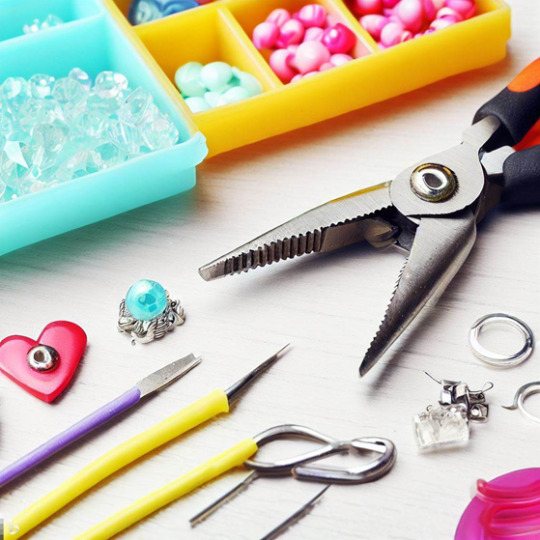
To diminish the import of quality supplies, especially Sterling Silver, is tantamount to sabotaging one's craft. Rings and earrings intended for children are not merely decorative trinkets but tangible manifestations of craftsmanship that involve a kaleidoscope of expertise.
Sterling Silver, with its blend of durability and aesthetic finesse, is an indispensable medium in this equation. It's not just material; it's a mélange of utility and artistry, optimal for sensitive skin and robust enough for the inevitable rigors of child play.
0 notes
Link
0 notes
Text
Blueberries and Cowboys: Chapter 2
A choose-your-own-adventure style fic. First, 2 platonic chapters for set-up/build-up. And then, the story will split into 2 paths depending on your romantic pairing preference: You and Thrawn, or You and Eli.
Chapter Masterlist
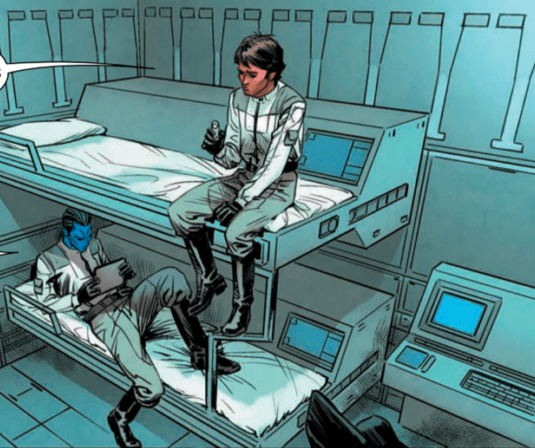
Chapter 2: The Plan
Pairing: None...yet...
Chapter Warnings: Mentions of bullying
Length: 2k
AO3 Link (In case you like it better over there, it’s okay, no judgement)
The rest of the week saw the three of you using every bit of free time outside your classes and studies to gather information for Thrawn to build a solid plan.
Eli tailed his pesky classmate Arden everywhere, even skipping a class one day to break into his dorm, trying to learn anything about the guy that could be useful to get him involved in the plot. Thrawn analyzed the simulation software and protocols that would be used to administer the tests, mapping out every possible way Commander Burdick could hijack it. And you were the one spying on the Burdick himself. Since the commander didn't seem too interested in your grades, you were able to shadow him without suspicion, and had been able to slip a bug into his offices to eavesdrop on any potential conversations about his plans for sabotage.
Your classmates and the staff were none the wiser. That was the advantage of being social outcasts. Half of them avoided you all like the plague, and the other half already thought you were weird people doing weird things. So it wasn't long before you'd all gotten enough intel to work with.
It was late in the evening at the end of the week. You found yourself in Thrawn and Eli's shared dorm, which looked identical to your own in the opposite wing, because the Empire couldn't bother with things like individuality or comfort. Eli sat on the edge of his top bunk, his legs swinging casually, and his coat unbuttoned to reveal a wrinkled undershirt you knew he hadn't bothered to wash all week. Thrawn paced about in the middle of the room, his long strides only allowing him about four good steps before he had to turn around. He still had his uniform on, boots and badges and all.
You leaned against the railing of the bed, watching Thrawn as he went back and forth. Sometimes he sat still when he was scheming, with his fingers steepled and his gaze seemingly reaching into some unknown dimension beyond your comprehension. That usually happened when he was running through variables that didn't concern you, at least from his perspective. You and Eli had accepted long ago there would always be parts of his plans he would never share with you. He was kind of a control freak like that.
But tonight, he seemed to be more welcoming of collaboration, hence his steady rhythm of pacing in front of you.
"Only one variable remains, as I see it," he was saying. "We understand how the commander will manipulate the system to cause a redundancy in the simulation, thus rendering the test impossible to finish successfully."
You and Eli shared a glance; the only person who truly understood how that was going to happen was Thrawn. He'd tried explaining numerous times but when it came to codes and tech, the two of you weren't able to fully keep up.
"We also know through your investigating," Thrawn motioned to you with what you thought was an impressed look, causing you to feel a little pride, "that the commander plans to only sabotage my test, believing it will be too suspicious if Eli also fails. He will also manipulate his false code to originate from the computer of his former lover Eva Carroway, who currently works in HR. So if an investigation does ensue, it will be traced to her and not him."
You and Eli chuckled under your breaths. It had been a little amusing when you'd discovered Commander Burdick was using this plan to not only undermine Thrawn, but also get revenge on his ex-girlfriend. But even more hilarious was how awkward Thrawn treated the subject. He had been quite perplexed to learn people could be so vindictive after a break-up. And any time he explained that detail of the plan, like he was doing now, he hesitated over his word choice. You couldn't tell if he only pretended to be confused about romantic relations, or if that was truly an area he found himself lost in.
If Thrawn noticed your snickering, he didn't respond to it, only continued to recap the plan. "We have also determined how we will expose the altered code naturally, so it does not cast suspicion on us... What was the word you used?"
"Backfire," said Eli.
"Yes. It would not due to have anyone suspect that we altered the test ourselves, or to have our concerns disregarded altogether. Thus, arranging for the maintenance crew to get a mild case of food poisoning so their performance checks are postponed to occur right before the tests will take care of that variable. At the least, they will fix the altered code and I will take the test as normal. At the most, they will report it and the commander faces expulsion."
"So..." said Eli through a yawn as he stretched. "What's left to work out, then?"
Now it was time for you and Thrawn to share a look.
"Were you not interested in involving your classmate, Arden Fey?" asked Thrawn in his soft, contemplative voice.
Eli shrugged. "Yeah. But Burdick's already got his scapegoat, his ex. So it'll be easier to keep him out of it. Whatever."
You could tell he was trying to be nonchalant. But just this morning, he had spent the entire walk between classes ranting about some new insults Arden had come up with, and how badly he wanted to show the guy up once and for all. You knew your friend wasn't feeling "whatever" about it.
"It's not a matter of ease or difficulty," Thrawn stated plainly. He had stopped pacing and was standing with hands behind his back, highlighting the broadness of his shoulders and the height of his stance. His presence seemed to fill up the whole room, and not for the first time, you were glad to be his friend and not his enemy.
"Yeah," you added in encouragement. "We just have to get creative. Find a way to make Arden a more appealing scapegoat than Burdick's ex. In fact...."
You trailed off as an idea occurred to you. You darted out of the room, surely leaving your two friends perplexed, but you would only be a second. You sprinted down the corridor toward the lifts, where a bulletin hung against the wall with fliers and pamphlets. One notice was a bit larger than the others, a promotion of an upcoming gala event to celebrate the Academy's anniversary. You ripped it off and went racing back to the boys' dorm room.
Eli had come down from the bunk and held a concerned look, probably prepared to follow you if you hadn't returned so quickly. Thrawn was still standing composed, but there was a curiosity in his eyes that made you smile.
You held up the poster in front of your chest. "What do you think the likelihood is of us playing successful matchmakers this week?"
Thrawn understood your idea almost immediately, looking down on you with a pleased smirk. It made you flush a little, to know the Chiss was impressed. You rarely had a chance to contribute good ideas when his mind worked so much faster than yours.
Eli caught on next, and he started to grin, the happiest you'd seen him in a while. His smile was infectious and you grinned back. Happy looked good on him.
"We know Eva's not shy with younger guys," you explained. "Before Burdick, she was fooling around with some intern in the med bay."
"And Arden's vain enough," added Eli. "If he thinks anyone's interested, he'll go for 'em."
"So we get him to ask her to the gala as his date...." you said.
"Burdick sees the two of them together...." said Eli.
"And realizes he can get back at his lover in another way, by pinning the sabotage on another student...." joined Thrawn.
The three of you stood together, proud and satisfied that yet another plan had finally worked out. It was almost worth the stressful studying and petty bullying and all the other unpleasant things you had to endure at this god-forsaken school, just to have fun moments like this with trusted friends.
"We should attend this gala as well," Thrawn said eventually, holding out a hand for the poster. He inspected it thoughtfully. "It is only a few days before the tests, so I hadn't planned to pay it any mind. But now...."
"Yeah, we should make sure Burdick's as jealous as we want 'im," nodded Eli.
You were secretly pleased. The plan was already a win-win, but now you would be able to go to the event yourself, too. You hadn't mentioned your desire to go to either of them before, figuring they weren't interested and not wanting to sound silly if you suggested it. But you did love dancing, and it was so very rare you got a chance to wear something other than your Imperial uniform.
"It's a dance," you noted, in case they couldn't tell by the details on the poster. "We'll need to go in pairs."
"I suppose it would make the most sense for you and Eli to go together," said Thrawn quietly.
You looked between the two, realizing both of them were flushed slightly. Eli's cheeks were dotted with pink, standing out amongst his dark brown features, while Thrawn had more of a purple tint to his face now, a color you'd never seen there before. You could feel yourself growing warm and uncomfortable as well. It was only a dance... only a way for you to enact a much more important plan... but it was the first time your trio had had to engage in anything other than platonic friendship. The balance of your group seemed to be shifting ever so slightly in this moment, and you had no way of knowing if it was for good or ill.
You cleared your throat, pushing away any feelings that might have been brewing in your chest, and instead calling focus back to the mission at hand.
"Actually, I think I'd better go with Thrawn. Whoever doesn't go with me would have to find their own date, and no offense Thrawn, but I think Eli has the better chance of asking someone else."
You hoped they hadn't noticed how hollow your voice sounded, how hard you were trying to keep yourself emotionless.
Eli was pinker than ever. "Uh, I highly doubt that..."
"You're not completely hated around here, you know," you said quickly. "Definitely not with the girls. You're not bad looking, you can be charming if you try, and you're... you know, human." You glanced at Thrawn and added again quietly, "No offense."
Thrawn shook his head. His color and demeanor had already slipped back into his usual neutral self. "No, I agree. Those are the dynamics of our peers and we must work with it. I will take you to the gala, Eli will find his own date, and all three of us will push Arden and Eva together as well. It's a good plan."
You all nodded in agreement. But there was a knot in your stomach, a nervousness you didn't quite understand. You cared very much for both Thrawn and Eli. They were your best friends, your only friends. As a group, you were bonded by your ostracism, protecting and supporting each other on your journey out of this hell-hole.
And separately, you had something special with each, too. You and Eli came from similar backgrounds, and had the same need to disconnect from your surroundings and just have a bit of fun every once in a while. The two of you had spent many late nights together, either hopping between bars, exploring the city, making each other laugh uncontrollably, or quietly sharing the honest thoughts you both buried far too deeply inside. Some nights you'd done all of the above, and returned to your dorm feeling both exhausted and renewed.
But Eli didn't always appreciate the finer things in life, and that's where you connected with Thrawn. He wasn't necessarily an optimist, but he had this way of noticing the beauty that existed everywhere around you, even in the most simple or mundane of moments. Everything had the potential to be interesting. His calm but strong presence had kept you grounded and sane throughout your studies here so far. Sometimes you would talk, other times you would simply be in the same space. And either way, you felt better about life.
You didn't exactly want your relationship with them to change. But you couldn't help but feel this gala would do just that....
Next Chapter: The Preparation >
Blueberry Path | Thrawn x reader
Cowboy Path | Eli x reader
#star wars#thrawn#eli vanto#thrawn x reader#eli vanto x reader#choose your own adventure#friendship#romance#friends to lovers#mitth'raw'nuruodo
58 notes
·
View notes
Text
RATS OF NEW AMERICA: THE CORPSE RAT AND THE JACKRAT
Scientific Name Rattus mortife and Rattus Felix Origin/Ancestry Black Rat (Rattus Rattus) Fancy rat (Rattus norvegicus domestica)
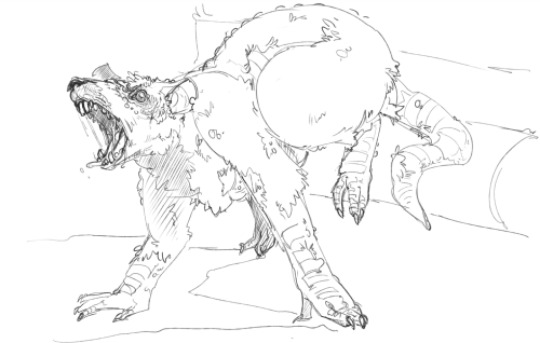
It seems that everywhere you find a group of humans, you'll find a clan of rats hiding in the shadows. This history seems born out of opportunity for the rat, but human's have done their part to help them get around the world rather easily. This commensalism - a relationship where one species benefits, but the other receives little or no harm - is probably the result of the sloppy nature of humans. The flagship rat species, Rattus Rattus, once originated in India, and while some of its cousins hung around on forest edges and fields, many found a living chasing down humans and loitering around their encampments for scraps. In more modern times, Rats are everywhere – at least everywhere that humans are. In almost every big city in the world, rats are eating human rubbish, breeding in human buildings, and running through city streets.
Even after 200+ years of nuclear fallout later, the relationship between man and rodent, be it good or not, has changed little. Even if the rodent's in question have. . . Scourge of the world, the pestilence bringer, the ever-present yet hardly welcome. Many titles are given to the Corpse Rat, a large deadly rodent-like creature found within the deep darkness of caves, sewers and chasms surrounding New America. Oversized version's of pre-War Black Rat (Rattus Rattus) , large eyes allow them to see in near pitch black, low light conditions, and their large ears are perfectly tuned for listening to the sounds of prey who stumbled too far into the darkness.
Opportunistic omnivores that feed on all matter of filth as well as the sick weak dying or already dead, their disgusting diet causes their saliva to usually be laced with a cocktail of often quite dangerous pathogens, most of which are unknown to even science. Even if prey was too survive the initial attack, they are doomed for a slow, painful agonizing demise by horrible disease. Despite however their nonexistent dental hygiene and highly aggressive nature, Corpse rats are fairly low down in the subterranean food chain kept in check by Corpsecleaner centipedes.
However they have been known to travel above ground at night to attack wayward children, unsuspecting wildlife and loose pets. As a result they are often killed on sight and are often one of the common animals in New America to have bounties put of their heads.
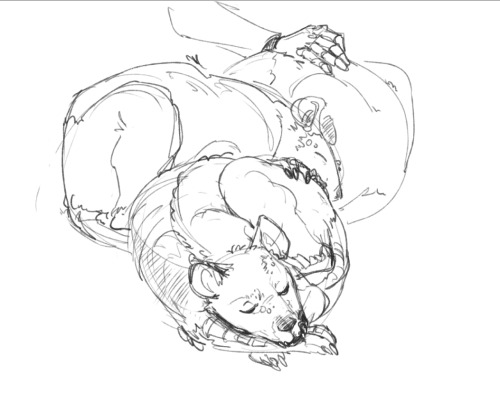
In addition to the Corpse Rat, another large rat species makes its home in the New America landscape. However unlike its more aggressive cousin, this one makes it’s home in the comfort of a couch curled up in a lap, then a dank dirty sewer.
The North American Jackrat, so named for their behavior of slapping their foot on the ground like a Jackrabbit when they are content, are the result of the North American rat population being tainted by the radioactive fallout from the onslaught of atomic warfare. However unlike Corpse-rat, Jackrats, once derived from Fancy pet rats (Rattus norvegicus domestica) , do not exhibit the same aggression that plagues their relatives, and instead have been domesticated as companions, adored and loved for their independent and loyal behavior, and high intelligence.
Not much separates the Jackrat from the Corpse-rat in terms of appearance. Much like the Corpse-rat, prolonged exposure to radiation has caused Jackrat to also double in size and age, with them growing to be the size of a medium sized dog, and where as their ancestor use to live only 2-3 years in captivity, Jackrats live almost triple that, ranging ages from 8-10 years, with the longest said to be almost 15.
One of the main differences in appearance between the two rodents is body-type. Jackrats are naturally a bit more smaller and more “plump” then Corpse-rat, with Jackrat having a rounder face, slightly rounder ears and a more healthy look to them, lacking a natural loss of fur and diseased look which is prevalent in Corpse-rat.
They also behave differently, as Jackrats are highly social animals, while Corpse-rat tend to be on the more solitary side outside of breeding pairs. Because of this, Jackrats can be housed together regardless of sex, as males are not all that aggressive towards one another. The same can not be said for the territorial Corpse-rat, who usually act intensely aggressive to any sex regardless. Being derived from fancy rats also gives Jackrats the ability to come in many forms of pattern and color, similar to those found in pre-war domesticated rats, that are not found outside in wild rat populations out-side of uncommon colors or morphs. Jackrats can also be taught to co-exist with other household pets, where as Corpse-rat are aggressive to anything and are more likely to kill then bond with their house-mates.
In comparison of the two animals, as in other pet species, a variety of colors, coat types, and other features that do not appear in the wild have either been developed, or have appeared spontaneously in Jackrat. Any individual rat may be defined one or more ways by its color, coat, marking, and non-standard body type.
In addition, many other variables separate Jackrat from Corpse-Rat
Corpse-Rat have a longer tail about the length of their body, While Jackrat's tail is half the length of their body.
Corpse-Rat are more slimly built then Jackrat, who have a more sturdy body-type
Jackrat have a more slanted, rounder face. Corpse-Rat have a pointed snout
Jackrat have larger ear's then Corpse-Rat.
Jackrat tend to be a rather large murid and can weigh twice as much as a Corpse-Rat
Both types can breed throughout the year if conditions are suitable, with a female producing up to five litters a year. Similar to common pre-war rat's, Females are capable of becoming pregnant immediately after giving birth, and can nurse one litter while pregnant with another. Compared to wild Corpse-Rat, Jackrat are shown to mate earlier, more readily, and for a longer period of time over their lifespan.
Corpse-Rat and Jackrat are opportunistic omnivores, similar to their ancestors. However Corpse-Rat are know to feed on all matter of filth as well as the sick weak dying or already dead, making them more carnivore then omnivore. Jackrat are considered true omnivores, eating a wide range of foods, including seeds, fruit, stems, leaves, fungi, and a variety of invertebrates and vertebrates. They are generalists, and thus not very specific in their food preferences, which is indicated by their tendency to feed on any meal provided for cows, swine, chickens, cats, and dogs.
Both species, have acute hearing, are sensitive to ultrasound, and possess a very highly developed olfactory sense. Their average heart rate is 300 to 400 beats per minute, with a respiratory rate of around 100 per minute.
#What is sought is most often found if it is truly sought: World Information#Fallout#Fallout 4#Fallout AU#Fallout World Building#Fallout 4 fauna#fallout fauna
30 notes
·
View notes
Text
FLIGHTLINE: 201 - US ARMY VTOL EXPERIMENTS # 3 - OTHER AVENUES
The US Army, despite limitations established after the USAF was established, continued to experiment with VTOL aircraft into the 1960s
BACKGROUND Recognizing the potential of winged heavier-than-air flying machines first demonstrated by the Wright Brothers in 1903, the US Army Signal Corps established the Aeronautical Division, Signal Corps on 1 August 1907 to train pilots, and develop and operate aircraft. Operations expanded and the name changed several times between then and 1941, when the US Army Air Corps was renamed the US Army Air Forces just prior to America's entry into WWII. During the post-war reorganization of the military and intelligence agencies formally adopted under the National Security Act of 1947, the USAAF was established as a separate branch under the National Military Establishment (renamed the Defense Department in 1949). Further refined by the 1948 Key West Agreement and the 1952 Pace-Finletter Memorandum of Understanding (MOU), the USAF was established as the primary operator of fixed wing aircraft for both offensive (fighter, bomber, attack), defensive (interceptor, long range recon) and support/transport duties, while the US Army's fixed wing fleet was limited to theater-level transport and utility, observation/spotting, command and control of Army forces, and medivac. Additionally, the Army was freed from weight restrictions and was allowed to develop helicopters for attack, transport and other roles. Seeking ways to develop more capable fixed-wing craft within those restrictions (or to side-step them entirely...), the Army began looking into various vertical takeoff and landing (VTOL) technologies in the 1950s, requesting proposals for one-man platforms, flying jeeps, and larger aircraft that could be adapted for recon, transport or perhaps even attack missions.
VERTOL VZ-2 On 15 April 1956 the Army and Navy signed a joint contract with Vertol (formerly Piasecki) to build a demonstrator to test tilltwing technology, that is, an aircraft built to allow the wing and engines to be tilted such that the thrust is pointing downwards, allowing the aircraft to take off vertically, then tilt the wing back down for forwards flight. The resulting Model 76 was a skeletal framework of aluminum tubing with a bubble cockpit at the front (both the frame and cockpit were adapted and built from components for the Bell Model 47 to reduce costs) with the high-mounted wing at mid point and a t-tail at the rear. A fixed taildragger landing gear was fitted, while a small wheel under the cockpit was also provided in case of difficulties. The Model 76 was 26' 5" long and 15' tall, with a wingspan of 24' 11". The three-bladed, variable-pitch props, each 9' 6" in diameter, were powered by a single Lycoming T53-L-1 turboshaft, rated at 700shp, which was mounted within the fuselage. A complex series of shafts and linkages connected the engine with the main rotors/propellers, as well as to a pair of smaller ducted fans, one each in the horizontal and vertical stabilizer, which were used to control yaw and pitch while in hover. The rotors, which were interconnected for safety, were also used to adjust pitch in hover, while more traditional aircraft flight surfaces would take over once in horizontal flight. Empty, the VZ-2 weighed 2,500lbs, while max weight was 3,700lbs.

-Line drawing of the Model 76. | Illustration: Boeing Vertol
Vertol delivered the aircraft, designated VZ-2 by the Army, in 1957, with ground testing beginning in April, followed by the first hover flight on 13 April. On 15 July 1958 the VZ-2 completed its first full flight, starting with a vertical takeoff, transitioning to wing-borne flight, then returning to hover mode for a vertical landing. The aircraft proved to be fairly agile, but was slow even in horizontal mode, setting a maximum speed of 210mph and a ceiling of 13,800 feet. Range, not particularly a concern of a research aircraft, was only 130 miles. In addition to the Army and Navy, the VZ-2 was flown by NASA for a time. The craft was retired in 1965, completing 450 flights, which included 34 full transitions. The VZ-2 is currently in storage at the Paul E. Garber Preservation, Restoration, and Storage Facility of the National Air and Space Museum.
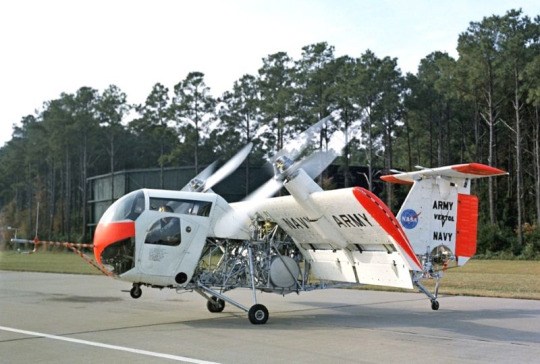
-The VZ-2, resplendent in white and day-glo orange scheme. | Photo: NASA
RYAN VZ-3 VERTIPLANE The Ryan Model 92 Vertiplane, designated the VZ-3RY by the Army, was designed to test the principle of deflected slipstream to enable a fixed-wing aircraft to achieve VSTOL without the complexity of a tilted wing or engine design. Originally built with a tailwheel design, the aircraft was rebuilt after a non-fatal accident in a slightly lengthened form with a tricycle arrangement. The high-mounted wing was fitted with full-width double-slotted flaps and down-turned wingtips that acted to contain and direct the airflow down, allowing the Vertiplane to take off after a 30-foot ground roll at a speed of just 25mph. Power was provided by an Avco Lycoming T53 turboshaft, mounted in the fuselage and shaft-linked to the two nine-foot diameter, three-bladed props. To provide control in a hover, the jet exhaust was fitted with a deflection nozzle. The aircraft could achieve a hover at altitudes up to 3,700 feet, but during testing it was discovered that a low-altitude hover would reingest air from its own slipstream (which possibly caused the crash). Construction of the Vertiplane began in 1957, with maiden flight taking place on 29 December 1958 and the Army completing 21 test flights before the VZ-3 crashed in 1959. Along with the rearranged landing gear, the rebuilt VZ-3 was also fitted with an open cockpit, bringing plane in its final configuration to 27 feet 8 inches long with a wingspan off 23 feet and a height of 10 feet 8 inches. After the rebuild the Vertiplane was handed over to NASA for further testing, and it was officially retired in 1961. In 2018, after a lengthy restoration, the VZ-3 was placed on display at the US Army Aviation Museum.
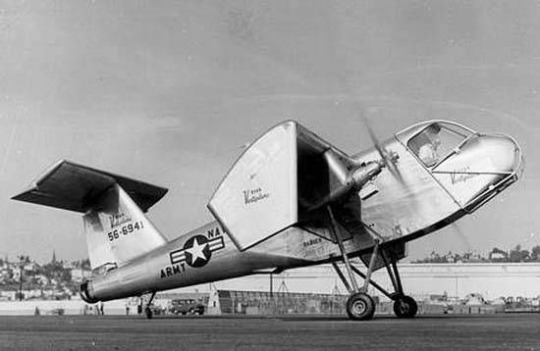
-The Vertiplane as originally completed. | Photo: US Army
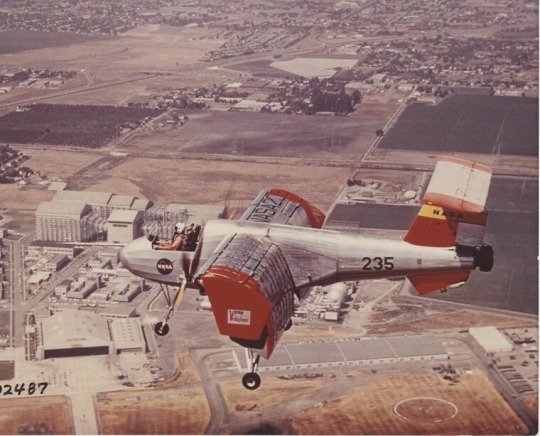
-The rebuilt VZ-3 during NASA testing. The span and length of the flaps at full extension is apparent in this view. | Photo: San Diego Air and Space Museum Archives
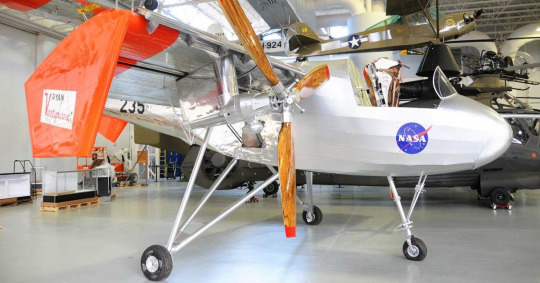
-The Vertiplane in the Army Aviation Museum. | Photo: US Army
DOAK VZ-4 Edmund R. Doak, Jr. was a self-taught aviation engineer and former VP of Douglas Aircraft who in 1940 formed Doak Aircraft. The company served as a subcontractor during WWII, eventually employing 4,000 workers. After the end of the war, Doak proposed a VTOL aircraft to the Army that would have the speed, range and firepower of a fixed-wing aircraft and the ability to take off vertically, hover and land vertically like a helicopter (which would also allow the Army to skirt the restrictions against operating fixed wing attack aircraft). On 10 April 1956 the Army awarded Doak a contract to build a single prototype of their Model 16 for use as a research aircraft. Designated the VZ-4DA and built with serial number 56,9642, the Model 16 was constructed from welded steel tube covered with fiberglass from the cockpit forward and with aluminum sheet over the remainder of the fuselage, which was 32 feet long. The mid-mounted wings were of all-metal construction and had two 5 foot diameter ducted fans on either wingtip, bringing the span to 25 feet 6 inches total. The fans could be moved through 92°, allowing the VZ-4 to take off vertically, fly horizontally, and hover (the fans pointed two degrees aft of vertical in hover to counteract the exhaust of the jet). Initially powered by a single Avco Lycoming YT53 turboshaft of 840shp, a more powerful T53-L-1 of 1,000shp was later substituted. As with the VZ-3, diverter vanes allowed the pilot to direct the thrust of the jet engine to control pitch and yaw in hover. In order to speed construction and cut costs, the VZ-4 utilized components from other aircraft, including the landing gear from a Cessna 182, the seats from a P-51 Mustang, and actuators from a T-33 Shooting Star. Despite being an R&D aircraft, the VZ-4 sat two, a pilot and observer, in tandem seats. The flight controls consisted of a standard stick and rudder, with mechanical linkages and interlocks adjusting the ducts, vanes, tabs and flaps as the aircraft went through all phases of flight. There was no artificial stabilization or power boost system.

-Orthograph of the VZ-4. | Illustration: Doak Aircraft Company
Doak began ground tests in February 1958, with the Model 16 completing 32 hours of stand testing and 18 of tethered testing before the first free flight on 25 February 1958, then the first full transition flight on 5 May. Following a complete tear-down inspection of the craft, it was shipped to Edwards AFB in October for 50 hours of further acceptance testing. The Army accepted the VZ-4 in September 1959, after which it was transferred to NASA Langley to begin test work on its VSTOL performance.
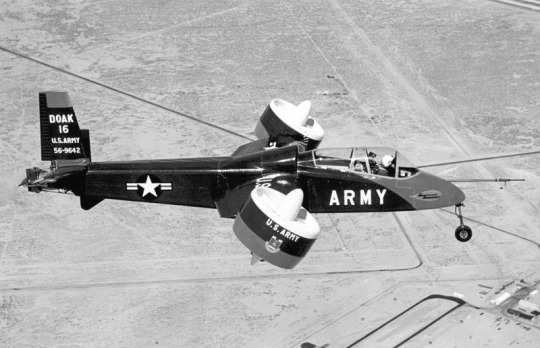
-The VZ-4 over Edwards in 1958. | Photo: US Army
The VZ-4 performed adequately during the Army and NASA tests; demonstrating the ability to hover and shift between horizontal and vertical flight at altitudes of up to 6,000 feet, A maximum speed of 230mph, a cruise speed of 175mph, a range of 250 miles with an an endurance of one hour, and a service ceiling of 12,000 feet. A few vices did crop up, the most serious of which was a tendency to nose-up when going from vertical to forward flight; additionally, STOL performance was less than anticipated. Doak's engineers were confident that they could correct these issues, with a swap to a more powerful T53 turbine being the first step. Before additional measures could be taken however, Doak, hit by financial problems due to a general recession in 1960, laid off 90% of their staff. The VZ-4 program was subsequently purchased by Douglas Aircraft, but by this point the Army had lost interest in the idea as improvements in aerodynamics and engines had produced helicopters which met their needs. The aircraft was transferred to NASA in 1963 and was flown sparingly until 1972, when it was grounded permanently. The VZ-4 was placed into storage at Fort Eustis in 1973 before being donated to the US Army Transportation Museum, where it is now on display.
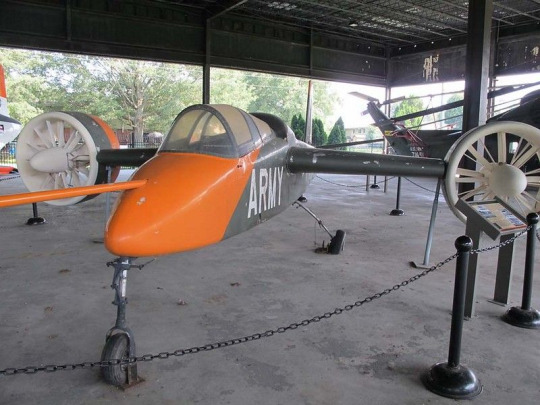
-The VZ-4 on display at the Army Transportation Museum. | Photo: Vladimir Yakubov
FAIRCHILD VZ-5 FLEDGLING Like the Ryan Vertiplane, the Fairchild VZ-5FA was designed to test the principle of deflected slipstream to enable VSTOL flight. Known as the Model M-244-1 by Fairchild, the aircraft was of simple construction, with an open cockpit fuselage nearly thirty-four feet long mated to a high-mounted wing nearly thirty-three feet in span. A GE YT58 turboshaft of 1,032shp drove four small four-bladed props as well as two even smaller props in the tail for pitch and yaw control. In addition to conventional flaps and ailerons for control in normal flight, nearly two thirds of the wing would act as a full-span flap for VTOL flight. Extensive wind tunnel testing at NASA Langley cast doubt on the airworthiness of the Fledgling's design, with the aircraft producing almost enough lift to carry its empty weight aloft, but no fuel, pilot or cargo. The VZ-5 was also determined to be unstable in every flight regime, with violent pitching encountered and the available flying surfaces unable to compensate. Despite this bleak report, Fairchild pressed on and tethered tests began on 18 November 1959. The exact number of tests of the Fledgling are not known but suspected be in the low single digits, and the series only reinforced the conclusions drawn from the wind tunnel testing. The VZ-5 was abandoned before the end of 1959 and was apparently quietly scrapped.
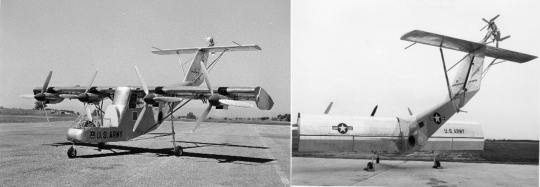
-The VZ-5 from in front and behind. The Fledgling likely never actually took flight, a victim of poor aerodynamics. | Photo: US Army
LOCKHEED VZ-10 HUMMINGBIRD In 1959 the Army awarded a contract to Lockheed for two examples of the VZ-10, an experimental STOVL observation aircraft based on Theodore von Karman's "augmented jet ejector" concept. Under von Karman's concept, jet exhaust was passed through a specially shaped chamber which drew in ambient air from the outside, which in lab tests had proven to increase thrust by two times. Lockheed's design resembled a conventional aircraft 32 feet long with narrow-chord, mid-mounted wings giving it a wingspan of just 25 feet. The interior volume of the fuselage was taken up by two P&W JT12A-3LH turbojets, along with the thrust diverter system. Fed by doors at the top of the fuselage, doors at the bottom would allow exhaust to lift the aircraft, while they could also be closed and allow the aircraft to take off and fly conventionally. Diverted exhaust could also be used to maneuver the aircraft during hover, while conventional flying surfaces were used during normal flight.
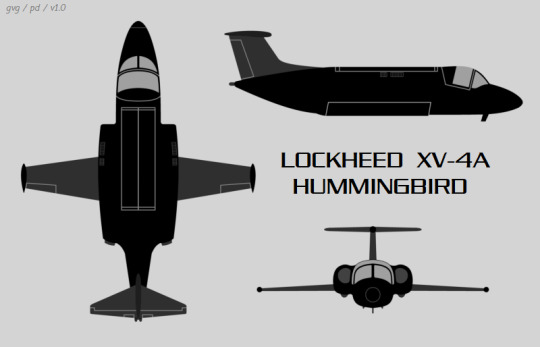
-Orthograph of the VZ-10. | Illustration: airvectors.net
Prior to first flight, the aircraft was redesignated the XV-4, with the maiden flight (conventional) occurring on 7 July 1962. This was followed up by a hovering flight on 24 May 1963 and a transitional flight from hover to conventional on 8 November 1963. The thrust augmentation system proved to be heavier and less effective than anticipated, resulting in the Hummingbird having a thrust-to-weight ratio of on 1.04. Still, the XV-4A set a max speed of 518mph and a range of 600 miles. The first XV-4 crashed on 10 June 1964, killing the pilot and destroying the plane.
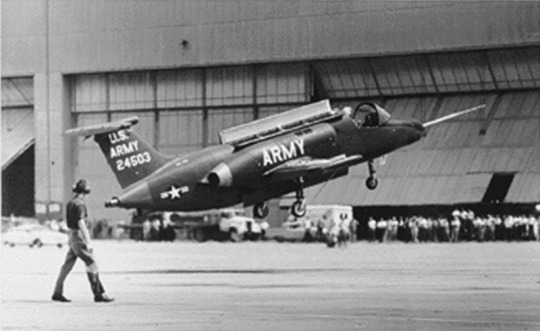
-The XV-4A Hummingbird during testing. | Photo: Lockheed/US Army
The second prototype was built to a different standard, designated the XV-4B. The two JT-12 engines and the diverter system were replaced by six GE J85 turbojets, four set vertically to act as lift jets and two set horizontally to provide forward thrust. The XV-4B was slightly larger than the A model, and much heavier, the A had an empty weight of just under 5,000lbs and a gross of 7,200lbs versus the B, which weighed 7,400lbs empty and almost 12,600lbs gross. The upgraded engines improved the thrust to weight ratio to 1.43, but the added weight reduced the top speed to 463mph. The XV-4B also had an improved stability system, giving the pilot a better feel for the controls and more authority in a hover. The aircraft was rolled out on 4 June 1968 and soon began a short builder's trial before being shipped to Edwards AFB for flight testing conducted by North American Rockwell on behalf of the USAF. The B model was lost in a crash on 14 March 1969, although the pilot was able to escape in the ejection seat. The Army canceled the program at this point, seeing no further development in the future.
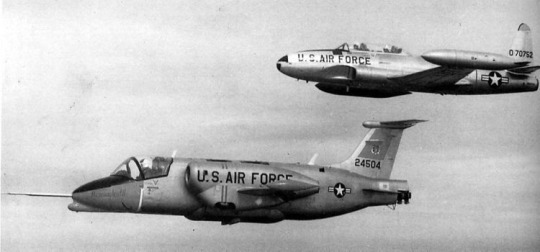
-The XV-4B, with a T-33 chase plane, at Edwards AFB. | Photo: USAF
RYAN VZ-11 VERTIFAN In 1959 Ryan Aeronautical, who had been working on the X-13 Vertijet, a jet plane that could VTOL onto a dedicated platform, for the USAF, proposed an aircraft operating on a different principal, ducted fans, to the US Army. The Army in turn awarded a contract for two VZ-11-RY Vertifans, redesignated the XV-5A in 1962.
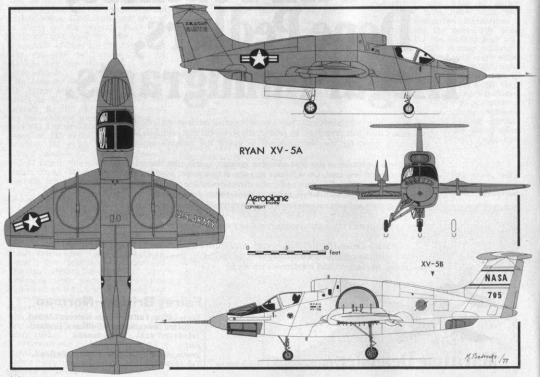
-Orthograph of the XV-5. | Illustration: Aeroplane Monthly
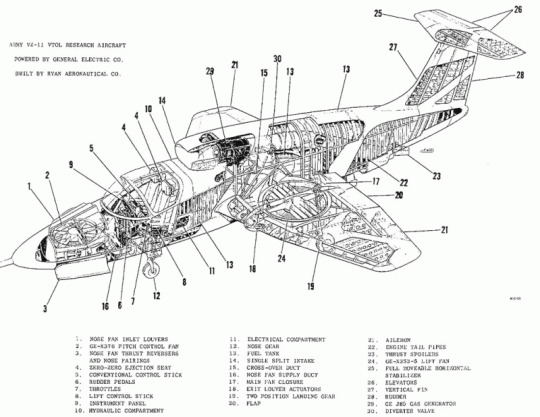
-Labeled cut-away drawing of the Vertifan. | Illustration: Ryan Aeronautical
The Vertifans were 44 feet 6 inches long, with a wingspan of 29 feet 10 inches and a height of 14 feet 9 inches. Empty weight was just over 7,500lbs, while max takeoff weight was 13,600 conventionally and 12,300lbs while employing VTOL. Two General Electric J85s, rated at 2,600lbs each, propelled the aircraft forward, as well as driving the two GE X353-5 ducted fans in either wing, which measured 62.5 inches in diameter, as well as a smaller 36in fan in the nose. While operating in lift-fan mode, the engines produced 16,000lbs total thrust, three times that available from the turbojets alone. Cross-ducts provided a measure of safety, as either jet could dive the whole system in case of a failure. Louvered vanes underneath the fans provided yaw and roll control, while pitch control was effected via engine power settings. Traditional flying surfaces on the wing and T-tail provided control in conventional flight. The vanes underneath the fans as well as doors on top could be closed during normal flight to reduce drag. Additionally, the narrow-track landing gear was retractable. The wings of the XV-5 were vaguely based on the delta wing of the A-4 Skyhawk, and the intake duct for the engines was placed above and behind the two place cockpit.

-This photo, from the front and underneath the XV-5A, shows the narrow track of the landing gear. | Photo: Ryan Aeronautical
While the XV-5s were under construction the 15 pilots chosen, known as the "XV-5A Fan Club", were trained on a flight simulator provided by Ryan. The first Vertifan was rolled out in early 1964, with the maiden flight taking place on 25 May. Testing progressed, but uncovered numerous issues with the aircraft. The J85s produced too little thrust, giving the XV-5 poor acceleration during conventional takeoffs. During hovers, the control system provided too little yaw authority, and opening and closing the louvers and doors caused abrupt changes in pitch. There were also issues with the opening mechanisms, which proved to have poor reliability. The first Vertifan crashed during a public flight demonstration on 27 April 1965, killing Ryan test pilot Lou Everett. The post-crash investigation determined that the Everett had inadvertently tripped the conventional-to-vertical conversion switch, which was mounted on the collective. The switch automatically triggered the horizontal stabilizer to force the nose down almost 45°, a maneuver intended to compensate for the lift generated by the nose fan. Everett initiated his low-altitude ejection seat, but it malfunctioned and he was killed.
The second Vertifan was modified, with the conversion switch, now a lift-lock toggle, being moved to the instrument panel. Trials resumed, with an emphasis on turning the plane into a search-and-rescue vehicle. A winch and rescue sling was added, with the idea being that a downed airman could be retrieved and winched into a compartment behind the pilot. During a test of the system on 5 October 1966, the sling was ingested into one of the wing fans. The pilot, Major David H. Tittle, ejected, but too late, and died of internal injuries he sustained when the seat impacted the ground. The plane was salvaged and rebuilt into the XV-5B, which featured fixed landing gear which was more widely spaced, improved controls, and improved lift and thrust capability. The Army, having lost interest in VTOL research in general and the Vertifan in particular, abandoned the project. The XV-5B was turned over to NASA for further testing, and was delivered in the agency's paint scheme of overall white with blue trim.
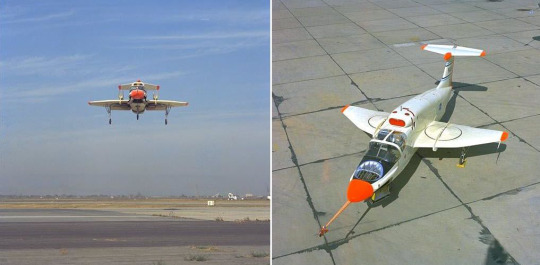
-Composite photo of the XV-5B in flight and on the runway. | Photo: NASA
The XV-5B continued to be flow by NASA until 1971, providing much data on lift fan technology. General Electric took some of the lessons learned from the J85 engines and X353 fans and adapted them into the earliest high-bypass turbofan engines, the TF39, which powered the C-5A Galaxy. The Verifan was the last manned aircraft produced by Ryan, which pivoted into unmanned aircraft in the mid 1960s. The XV-5B, still in its white NASA paint scheme, was retired and placed on display at the US Army Aviation Museum at Ft Rucker.
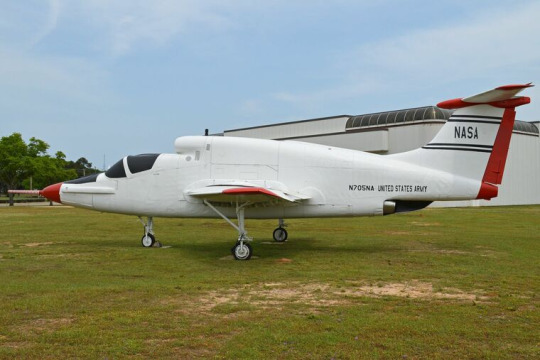
-The XV-5B Vertifan, on display outside the US Army Aviation Museum. | Photo: Alan Wilson.
SUMMARY The Army ceased supporting VTOL research during the late 1960s. Budgets were stretched by the war in Vietnam, and development of more capable helicopters like the UH-1, AH-1 and CH-47, resulted in a diminished interest in alternative technologies.
#airplane#aircraft#airplanes#vtol#us army#naca#nasa#the fifties#the sixties#the 50s#the 60s#Cold War#coldwar#cold war history#ryan aircraft#lockheed#Fairchild republic#boeing vertol#Aviation#avgeek#vstol#stovl
3 notes
·
View notes
Text
Big Bertha Irons - A Brief History
Big Bertha. In the world of golf, this is a name that is synonymous with forgiveness, feel, and performance. Introduced by Callaway Golf in 1994, the Big Bertha Irons began a mouseover with an iron designed to push pressures to the margins of the club. This unique design became the foundation upon which Callaway would continue to improve, amazing ourselves with each and every new model. In 1996, Callaway released an updated interpretation of the original Big Bertha Irons with a few modifications. In the new model, designers used the extent of the club head and the amount of the hollows to push pressures farther out to the edges of the club head. A Bore-through hosel which actually extends through the club rods rendering more steadfastness and the emotion that is expected of all Callaway products. The Sole was modified slightly configuration to allow for the club to pass through poor lies with even less scraping than the before.

Callaway also introduced the Big Bertha Gold Series Iron in 1996. Using the prototype of the original Big Bertha Iron, designers repositioned the sweet spot, added a new contoured sole and redistributed the compression in the head. The Big Bertha Gold Series has a RCH Series 96 shaft and are manufactured from an aluminum bronze alloy for a softer feel. The Gold Series Iron retained the original's 360-degree undercut channel and the consistently thin face. The Great Big Bertha Tungsten Titanium Iron hit the encircling in 1997. In this design, Callaway used Titanium with a Tungsten insert to create a club top that was perfect for use in just about all conditions. The Insert represents only 15 percent of the club head capacity but description for 40 percent of the weight, maintenance the degree perfect and the hearts of severity exactly where it should be.
The Big Bertha X-12 Irons and X-12 Pro Series Irons followed in 1998. Featuring a lower core of solemnity than the original Big Bertha Irons, the X-12 was designed to assistance golfers get the heavens airborne. The X-12's retained the 360-degree undercut channel, Callaway's patented S2H2 and Tru-Bore Technologies. The Pro-Series was designed for lower handicap golfers and featured the Less-Offset formatting which enables the more experienced golfer the talent to work the sky more easily. Also featured are the 360-degree undercut channel, the S2H2 and Tru-Bore Technologies. The X-12 Irons were the first Stainless Steel Irons introduced by Callaway and many believe it was this iron that set the ancestor for high attainment irons to follow. The Steelhead X-14 Irons followed the X-12 in 2000 and quickly became the best-selling Iron in Callaway history. Also offered in a Pro-Series, the X-14 featured stainless steel construction and Callaway's Variable Face Thickness (VFT) Technology that ensured a perfectly located center of seriousness (COG). Optimized in the long, mid and the shot iron, the Face Thickness tapered from vertex to beds and scoundrel to toe. The Pro-Series designed for the advanced golfer was designed with Less-Offset than the regular X-14
Callaway's original Big Bertha Irons were upgraded once more in 2002. In this iron set, Callaway added all of it's latest technologies which accordance the original and very popular appearance and shape the Big Bertha Irons were known for. These technologies took the windowpane of the golfer using them to a whole new tier with increased pity and maximum performance. Also introduced in 2002 was the Hawk Eye VFT Irons. Quite simply, in this set, Callaway simply used all of their design learning and added the titanium package. The bulk popular addition to the Hawk Eye VFT irons, however, was the internal weight pocket that allowed designers to policies the crowd middle and low across the clubface. This design provides for unequaled path without sacrificing pity or feel. The chasing year, Callaway went back to the layouts crew to create the new Steelhead X-16 and the Steelhead X-16 Pro-Series. Changes included a shorter paddle extensiveness and wider topline plus the addition of Callaway's latest technology, Notch Weighting. The X-16 features included a low center of gravity, a cambered sole, and a satin finish. The Pro-Series were given a more blade-like design, Less-Offset, a thinner topline, narrower sole, and a straighter leading edge.
With best online shopping experience, Frishay is designed for our Worldwide customers needs. Get the latest products with great discounts. Our Golf Club P7TW Irons is really amazing. We have variety of lengths available from which you can choose.
1 note
·
View note